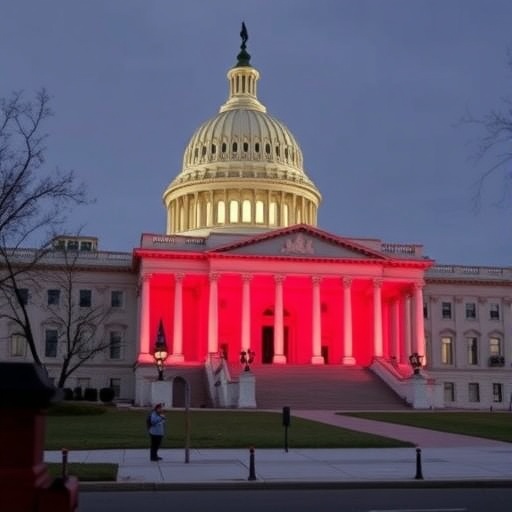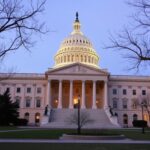U.S. Government shutdown Surpasses 21 Days: Democrats Block GOP Funding Bill, Leaving 750,000 Federal Workers Unpaid
In a stunning escalation of partisan gridlock, the U.S. federal Government shutdown has dragged into its 21st day, as Democrats in Congress decisively blocked a Republican-led funding bill aimed at averting further chaos. With over 750,000 federal employees now facing their second paycheck without compensation, families across the nation are grappling with mounting bills and uncertain futures. This prolonged standoff between Democrats and Republicans not only strains essential services but also casts a shadow over the economy, highlighting deep divisions in Washington just months before critical midterm elections.
- Federal Employees Brace for Second Unpaid Paycheck Amid Shutdown Turmoil
- Democrats Slam GOP Funding Bill as ‘Political Ploy’ in Shutdown Standoff
- Essential Services Strain Under Prolonged Government Shutdown Pressure
- Republican Push for Compromise Falters as Shutdown Enters Record Territory
- Path Forward: Midterm Shadows and Economic Warnings Loom Over Shutdown Resolution
The blockage occurred late Thursday evening during a heated House vote, where the GOP proposal to extend funding through November 21 failed to secure the necessary support. Democratic leaders decried the bill as a ‘Trojan horse’ for unrelated policy riders, while Republicans accused their counterparts of playing politics with American livelihoods. As the shutdown enters uncharted territory—surpassing the 16-day record from 2013—questions swirl about how much longer the American public can endure the fallout.
Federal Employees Brace for Second Unpaid Paycheck Amid Shutdown Turmoil
For federal employees like Sarah Jenkins, a National Park Service ranger in Virginia, the Government shutdown has transformed daily life into a precarious balancing act. Jenkins, one of the 750,000 workers furloughed or working without pay, shared her story with reporters outside the Capitol. ‘We’ve been told to report for duty, but no one’s telling us when—or if—we’ll get paid,’ she said, her voice cracking with frustration. ‘My kids don’t understand why we can’t afford their school supplies this month.’
The financial ripple effects are profound. According to the Office of Personnel Management, approximately 800,000 non-essential federal workers were initially furloughed, but many have been recalled on a staggered basis to maintain core operations. However, the lack of back pay guarantees has led to widespread anxiety. A recent survey by the National Treasury Employees Union revealed that 62% of affected workers are dipping into savings, while 28% have turned to credit cards or loans to cover essentials like mortgages and groceries.
Economists estimate the shutdown’s cost to federal workers alone at over $2 billion in lost wages per week. In cities like Washington D.C., where the federal workforce is a economic backbone, local businesses are feeling the pinch too. Restaurants near government buildings report a 40% drop in lunchtime crowds, and real estate agents note a slowdown in housing markets as families hesitate to commit without steady income.
Personal stories underscore the human toll. In Colorado, IRS employees working without pay are delaying medical treatments, while Coast Guard families in California have launched GoFundMe campaigns to buy diapers and formula. ‘This isn’t just about politics; it’s about real people,’ said Rep. Nancy Pelosi (D-CA), the House Speaker, in a floor speech. ‘These federal employees are patriots serving our nation, and they’re being held hostage by partisan games.’
Democrats Slam GOP Funding Bill as ‘Political Ploy’ in Shutdown Standoff
The blocked funding bill, introduced by House Republicans, sought to provide a short-term extension of government operations until November 21, allocating $5.7 billion for discretionary spending. However, Democrats swiftly rejected it, citing embedded provisions they viewed as non-negotiable demands on immigration and border security—issues that have fueled the shutdown from the outset.
Senate Majority Leader Chuck Schumer (D-NY) led the charge against the measure, calling it ‘a blatant attempt to force through extreme policies under the guise of averting crisis.’ In a press conference, Schumer outlined key objections: the bill included $1.3 billion for wall construction along the southern border, a longtime Republican priority that Democrats have repeatedly opposed. ‘We’re not going to reward obstructionism with concessions,’ Schumer declared. ‘The American people deserve a clean funding bill, not one laced with poison pills.’
On the Republican side, House Minority Leader Kevin McCarthy (R-CA) fired back, accusing Democrats of intransigence. ‘This shutdown is on the Democrats’ hands,’ McCarthy stated during a Fox News interview. ‘Our funding bill was a reasonable compromise to get workers paid and services running. But they chose ideology over people.’ GOP strategists point to polling data from Quinnipiac showing 54% of voters blaming both parties equally, but with Democrats edging out in public disapproval for prolonging the impasse.
The partisan divide isn’t new; it’s rooted in broader battles over spending priorities. Republicans argue that unchecked federal spending under Democratic control exacerbates the national debt, now hovering at $31 trillion. Democrats counter that Republican proposals shortchange vital programs like veterans’ benefits and disaster relief, which were also at risk in the blocked bill. This back-and-forth has stalled negotiations, with no bipartisan talks scheduled as of Friday morning.
Essential Services Strain Under Prolonged Government Shutdown Pressure
Beyond the immediate hardships for federal employees, the government shutdown is severely testing the nation’s infrastructure. Essential services, from air traffic control to food safety inspections, continue but with reduced capacity, leading to delays and safety concerns nationwide.
At major airports, the Federal Aviation Administration operates with skeleton crews, resulting in flight delays averaging 45 minutes longer than usual, per data from FlightAware. Travelers like Mark Thompson from Chicago described chaos at O’Hare: ‘Security lines were endless, and no one knew when planes would take off. It’s like the government’s absence is grounding the entire country.’
The Department of Agriculture’s suspension of meat and poultry inspections has halted exports worth $300 million weekly, hitting farmers in the Midwest hard. In a statement, USDA Secretary Tom Vilsack warned of potential food shortages if the shutdown persists: ‘We’re seeing backlogs at processing plants, and consumers could face higher prices for everything from beef to eggs.’
Environmental protections are also faltering. The Environmental Protection Agency has paused routine water quality tests in over 20 states, raising alarms about undetected contamination. In Flint, Michigan—still recovering from its own water crisis—local officials are scrambling to fill the gap with state funds. Meanwhile, national parks remain open but understaffed, leading to increased vandalism and trash accumulation. A viral video of overflowing garbage bins at Yosemite has garnered over 1 million views, amplifying public outrage.
Healthcare services face unique challenges. The National Institutes of Health has halted new patient enrollments in clinical trials, delaying treatments for cancer and rare diseases. ‘Patients are suffering because bureaucrats can’t agree,’ lamented Dr. Elena Ramirez, a researcher in Bethesda, MD. Social Security offices, while processing benefits, are overwhelmed, with phone wait times exceeding two hours.
The economic toll mounts daily. The Congressional Budget Office projects a $1.5 billion hit to GDP per week of shutdown, with small businesses bearing much of the brunt through lost contracts and tourism dips. In Hawaii, where federal lands drive 10% of the economy, hotel bookings have plummeted 25%.
Republican Push for Compromise Falters as Shutdown Enters Record Territory
As the government shutdown surpasses 21 days, Republicans are intensifying efforts to portray Democrats as the villains in this fiscal drama. House Speaker Paul Ryan, in a rare address to the nation, urged swift action: ‘Enough is enough. Our funding bill was a lifeline—thrown away by those more interested in headlines than helping families.’
Behind the scenes, GOP leaders have floated alternative proposals, including a ‘clean’ continuing resolution stripped of controversial riders. Yet, trust remains eroded. A leaked memo from Senate Republicans reveals frustration with President Trump’s insistence on linking funding to border wall money, a stance that has complicated bipartisan overtures.
Public opinion is shifting. A new Washington Post-ABC News poll indicates 61% of Americans view the shutdown negatively, with independents—key to the midterms—leaning toward Democrats for their resistance to what they call ‘unfunded mandates.’ Veteran GOP Senator Lindsey Graham (R-SC) broke ranks slightly, telling CNN, ‘We need to swallow our pride and pass something temporary. The base will understand.’
Historical context adds weight. This is the third shutdown in five years, costing taxpayers $11 billion in lost productivity during the 2018-2019 episode alone. Analysts from the Bipartisan Policy Center warn that prolonged closures erode faith in institutions, potentially fueling populist movements on both sides.
In affected communities, grassroots efforts are emerging. Unions have organized food drives for federal employees, while cities like Austin, Texas, offer utility bill deferrals. These stopgaps highlight the patchwork response to a national failure.
Path Forward: Midterm Shadows and Economic Warnings Loom Over Shutdown Resolution
With the November midterms looming, the government shutdown injects volatility into an already tense political landscape. Democrats, buoyed by suburban gains in 2018, see the impasse as a rallying cry against Republican extremism. Campaign ads in battleground states like Pennsylvania and Michigan now feature testimonials from furloughed workers, framing the vote as a referendum on governance.
Republicans, meanwhile, are mobilizing their base with messages of fiscal responsibility. The RNC has launched a $10 million ad buy targeting ‘Democratic obstruction,’ linking it to broader issues like inflation and border security. Political forecasters from FiveThirtyEight predict the shutdown could cost the GOP 10-15 House seats if unresolved by Election Day.
Economically, the stakes are higher. Federal Reserve Chair Jerome Powell, in congressional testimony last week, cautioned that extended uncertainty could dampen consumer spending and hiring. ‘We’re monitoring closely,’ Powell said. ‘A prolonged shutdown risks tipping the economy into recession.’ Wall Street echoes this, with the Dow Jones dipping 2% in the past week amid fears of credit rating downgrades.
Resolution paths remain murky. Optimists point to backchannel talks between moderate senators from both parties, potentially yielding a bipartisan deal by next week. Pessimists, including White House aides, foresee a ‘shutdown within a shutdown’ if demands harden. International allies, from the EU to Canada, have expressed concern over delayed trade deals and diplomatic voids.
For federal employees and everyday Americans, the wait continues. As one anonymous Treasury worker put it, ‘We’re not pawns in this game. We just want to get back to work and get paid.’ The coming days will test whether Democrats and Republicans can bridge the divide, or if the nation hurtles toward deeper crisis.









